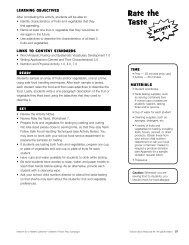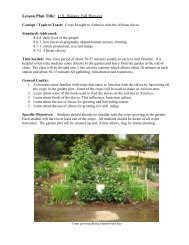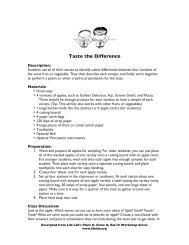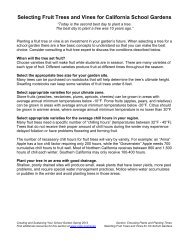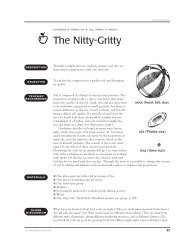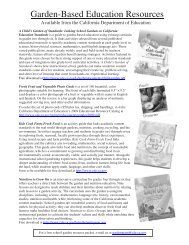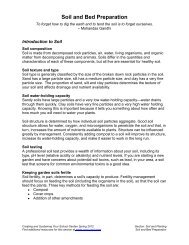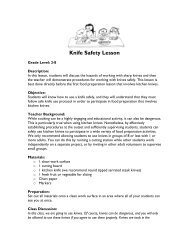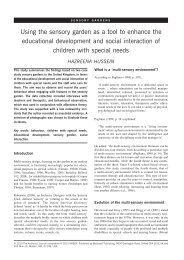Green Beans - Harvest of the Month
Green Beans - Harvest of the Month
Green Beans - Harvest of the Month
- No tags were found...
You also want an ePaper? Increase the reach of your titles
YUMPU automatically turns print PDFs into web optimized ePapers that Google loves.
S tudent Sleuths1 Why is nitrogen important for plant growth?2 What is rib<strong>of</strong>lavin? Name three things rib<strong>of</strong>lavin does for<strong>the</strong> body.3 Illustrate <strong>the</strong> two cotyledons, hypocotyl, epicotyl, andplumule that form during green bean growth.4 What were some <strong>of</strong> <strong>the</strong> harvesting techniques for greenbeans practiced by Native Americans as observed byearly explorers?5 What does <strong>the</strong> “three sisters <strong>of</strong> life” refer to in greenbean history? (Hint: Question #1 should help in findingthis answer.)For information, visit:www.fruitsandveggiesmatter.gov/month/fresh_beans.htmlwww.ipmcenters.org/croppr<strong>of</strong>iles/docs/cabeans-green.htmlwww.mypyramid.govHome Grown Factsn California ranks third in national production <strong>of</strong> greenbeans*.n Ninety-five percent <strong>of</strong> <strong>the</strong> green bean crop in California ismarketed as fresh and about five percent as processed.n Tulare, Orange, and San Luis Obispo counties are <strong>the</strong>largest green bean-producing areas in California.n O<strong>the</strong>r counties that contribute acreage to green beansinclude Riverside, Santa Clara, Contra Costa, Stanislaus,San Diego, San Mateo, and San Bernardino.n Bush-type green beans are <strong>the</strong> predominant varietygrown for commercial production in California.*2008 DataFor more information, visit:www.anrcatalog.ucdavis.edu/pdf/7240.pdfA String <strong>of</strong> <strong>Green</strong> Bean HistoryThe common bean was cultivated in ancient Mesoamericaas early as 8,000 years ago. <strong>Beans</strong> were even found in<strong>the</strong> mummy covering <strong>of</strong> a woman in a Peruvian cemeterydating back to pre-Inca civilization. <strong>Green</strong> beans andall 200 varieties <strong>of</strong> P. vulgaris originated in <strong>the</strong> tropicalsou<strong>the</strong>rn part <strong>of</strong> Mexico, Guatemala, Honduras, and part <strong>of</strong>Costa Rica. They spread from this center <strong>of</strong> origin to Northand South America long before European explorers everarrived.Early explorers found <strong>the</strong> climbing beans planted alongsidemaize. The first drawings <strong>of</strong> <strong>the</strong> bush bean were recordedby <strong>the</strong> German doctor Leonhart Fuchs in 1542, and werealso described in detail by explorers John Verazanno andSamuel de Champlain.When first discovered, <strong>the</strong> green beans had a “string” thatran on <strong>the</strong> outer curve <strong>of</strong> <strong>the</strong> pod shell. This led to <strong>the</strong>nickname “string beans.” [See Botanical Facts (page 2) fordetails.] Botanists, however, found a way to remove <strong>the</strong>string through breeding and in 1894 <strong>the</strong> first “stringless”bean plant was cultivated. Today, nearly all varieties <strong>of</strong>edible pod beans are grown without strings.For more information, visit:www.extension.iastate.edu/healthnutrition/foodrecipeactivity/foodSchool Garden: Where <strong>Beans</strong> GrowIf your school has a garden, here is an activity you may want to implement.Look for donations to cover <strong>the</strong> cost <strong>of</strong> seeds, tools, irrigation systems,electric pumps, and any salary incurred by garden educators or o<strong>the</strong>rs.What You Will Need:n Bean seeds, soaked overnightn 4 plant containers (per group <strong>of</strong> 4 students)n Potting soiln Rulersn Graph paperActivity:n Discuss factors that impact <strong>the</strong> growth <strong>of</strong> beans(e.g., air, water, nutrients, temperature).n Divide students into groups. Distribute containers toeach group. Label containers with group name.n Students place soil in three <strong>of</strong> <strong>the</strong> four containers; add abean seed to each container.n Each group places containers in a different location: onenear sunlight, one away from sunlight and covered withdark paper, one in a cold dark place (e.g., refrigerator),and <strong>the</strong> one with no soil near <strong>the</strong> window.n Students water <strong>the</strong> seeds daily, being careful not tooverwater.n Measure weekly <strong>the</strong> growth rates <strong>of</strong> each seed usingrulers.n Graph results for each container using a bar graph.n Make predictions regarding growth over time.n Discuss how <strong>the</strong> various environmental influencesimpact <strong>the</strong> growth rate. Make connections to howfarmers are impacted by environmental influences(wea<strong>the</strong>r, drought, pollution).For more ideas, visit:www.cangc.orgJust <strong>the</strong> Factsn <strong>Green</strong> beans are nitrogen fixers, which means <strong>the</strong>y have<strong>the</strong> ability to draw nitrogen from <strong>the</strong> air and return it to<strong>the</strong> soil. Because <strong>of</strong> this, farmers <strong>of</strong>ten plant beans andlegumes in <strong>the</strong>ir crop rotations to replenish <strong>the</strong> soil.n Fresh beans are classified into two basic categories:edible pod and shell beans (also called dry beans*).<strong>Green</strong> beans are <strong>the</strong> most popular edible pod bean,while lima beans are <strong>the</strong> most common shell bean soldin <strong>the</strong> United States.*Refer to Dry <strong>Beans</strong> Newsletter on www.harvest<strong>of</strong><strong>the</strong>month.com.




